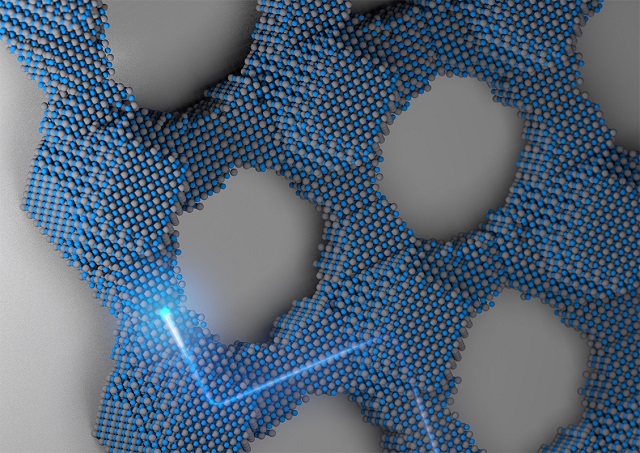Feb 25 2016
A team of scientists from Cornell University have developed atomically coherent quantum dot solids, which are 2D superstructures fabricated from single-crystal building blocks. Years ago, single-crystal silicon wafers redefined the very nature of electronics.
 Connecting the dots: Playing LEGO at the atomic scale to build atomically coherent quantum dot solids. Credit: Kevin Whitham/Provided
Connecting the dots: Playing LEGO at the atomic scale to build atomically coherent quantum dot solids. Credit: Kevin Whitham/Provided
This latest breakthrough could pave the way for next-generation electronics, with potential applications in the field of optoelectronics.
To develop the quantum dots the multidisciplinary team used directed assembly and attachment techniques, which involved synthesis of lead selenide quantum dots to create larger crystals. These crystals were merged together to create square-shaped superlattices, which are atomically coherent. Tobias Hanrath, associate professor in the Robert Frederick Smith School of Chemical and Biomolecular Engineering, along with Kevin Whitham, a graduate student, headed the study.
The atomic coherence of these 2D superlattices differentiate them from earlier crystalline structures. Instead of being fused by a substance between each crystal, the superlattices are directly fused to each other. The superstructures are also considered to have better electrical properties than present-day semiconductor quantum dots, and as a result, hold immense potential in solar cells and similar electronic devices.
As far as level of perfection, in terms of making the building blocks and connecting them into these superstructures, that is probably as far as you can push it.
Tobias Hanrath, Associate Professor, Robert Frederick Smith School of Chemical and Biomolecular Engineering
The paper, titled “Charge transport and localization in atomically coherent quantum dot solids,” has been reported in Nature Materials.
Most of the experimentation work was handled by Whitham, a doctoral candidate in engineering and materials science and who is also the lead author of the study. Other researchers who contributed to the work include Jun Yang, postdoctoral researcher; Lena Kourkoutis, assistant professor and Morgan Sesquicentennial Faculty Fellow in applied and engineering physics; Benjamin H. Savitzky, graduate student in physics; and Frank Wise, the Samuel B. Eckert Professor of Engineering.
The new study was the culmination of the previous research performed by the Hanrath team, including a paper that appeared in Nano Letters in 2013 describing a novel technique for joining quantum dots via regulated displacement of a connector molecule known as ligand. According to that paper, there is a major obstacle that need to be resolved, which is ‘connecting the dots’ or electronically connecting the quantum dots.
The latest study appears to have resolved this issue. The strong electronic coupling of each quantum dot results in energy bands, which can then be exploited depending on the makeup of crystals. This could be the first stage for designing innovative materials that have programmable electronic structure.
However, according to Whitham, more research is needed to bring lab-scale results to technological realization. While the superlattice structure is relatively better than the quantum dot solids connected by ligands, it has many sources of disorder, and quantum dots are different from each other, which is contrary to atoms found in normal solids. As a result defects are produced, which tend to restrict the propagation of the electron wave function.
I see this paper as a challenge for other researchers to take this to another level. This is as far as we know how to push it now, but if someone were to come up with some technology, some chemistry, to provide another leap forward, this is challenging other people to say, ‘How can we do this better?’
Kevin Whitham, Graduate Student, Cornell University
Hanrath claimed that the latest discovery can be considered in either way – based on how we view the glass as half full or half empty.
It’s the equivalent of saying, ‘Now we’ve made a really large single-crystal wafer of silicon, and access to high-quality samples yields new understanding and technological advances.’ That’s the good part, but the potentially bad part of it is, we now have a better understanding that if you wanted to improve on our results, those challenges are going to be really, really difficult.
Tobias Hanrath, Associate Professor, Robert Frederick Smith School of Chemical and Biomolecular Engineering
The researchers used the Cornell Center for Materials Research for their study. The center is supported by the National Science Foundation via its Materials Research Science and Engineering Center program. Additionally, X-ray scattering was performed at the Cornell High Energy Synchrotron Source, which is supported by the National Institutes of Health and the National Science Foundation.